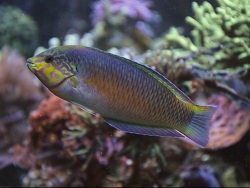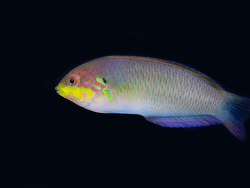Info
Shepard & Meyer, 1978
Macropharyngodon moyeri inhabits areas of boulders and rubble with high algal cover in depths of 7-17 m.
It likely feeds on micro-zoobenthos and may be found as bycatch in the aquarium trade.
Source: IUCN
Classification: Biota > Animalia (Kingdom) > Chordata (Phylum) > Vertebrata (Subphylum) > Gnathostomata (Superclass) > Pisces (Superclass) > Actinopterygii (Class) > Perciformes (Order) > Labroidei (Suborder) > Labridae (Family) > Macropharyngodon (Genus) > Macropharyngodon moyeri (Species)
Jumping guard
A jumping guard prevents (nocturnal) fish from jumping out.
Wrasses, blennies, hawkfishs and gobies jump out of an unprotected tank in fright if their night rest is disturbed, unfortunately these jumpers are found dried up in the morning on carpets, glass edges or later behind the tank.
https://www.korallenriff.de/en/article/1925_5_Jump_Protection_Solutions_for_Fish_in_the_Aquarium__5_Net_Covers.html
A small night light also helps, as it provides the fish with a means of orientation in the dark!
Macropharyngodon moyeri inhabits areas of boulders and rubble with high algal cover in depths of 7-17 m.
It likely feeds on micro-zoobenthos and may be found as bycatch in the aquarium trade.
Source: IUCN
Classification: Biota > Animalia (Kingdom) > Chordata (Phylum) > Vertebrata (Subphylum) > Gnathostomata (Superclass) > Pisces (Superclass) > Actinopterygii (Class) > Perciformes (Order) > Labroidei (Suborder) > Labridae (Family) > Macropharyngodon (Genus) > Macropharyngodon moyeri (Species)
Jumping guard
A jumping guard prevents (nocturnal) fish from jumping out.
Wrasses, blennies, hawkfishs and gobies jump out of an unprotected tank in fright if their night rest is disturbed, unfortunately these jumpers are found dried up in the morning on carpets, glass edges or later behind the tank.
https://www.korallenriff.de/en/article/1925_5_Jump_Protection_Solutions_for_Fish_in_the_Aquarium__5_Net_Covers.html
A small night light also helps, as it provides the fish with a means of orientation in the dark!







 AtlantisAquarium
AtlantisAquarium






















